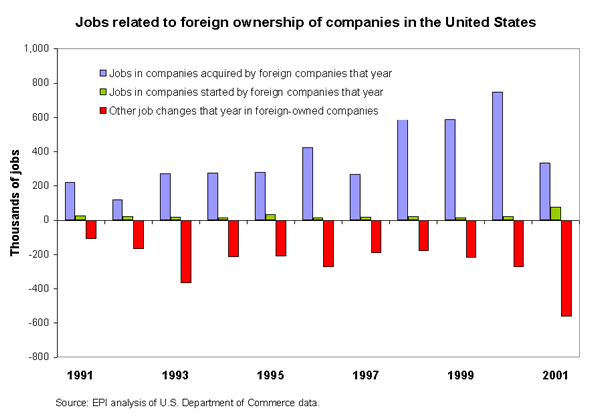This Snapshot is the first of a two-part series; part two appeared on April 7, 2004.
Outsourcing, the process of U.S. firms shifting work abroad, has become one of the hottest topics in current trade debates. Some people, however, have also raised questions about “insourcing,” the phenomenon by which foreign companies increase their investments and employment in the United States. Some have suggested that the jobs lost to outsourcing are offset by the millions of American workers hired by foreign companies to produce new goods and services. However, the vast majority of employment associated with new investments by foreign companies has taken the form of acquisitions of ongoing U.S. companies, such as Daimler’s takeover of Chrysler. As a result of insourcing, 2.78 million U.S. jobs were lost in foreign-owned firms between 1991 and 2001.
The Bush Administration has credited insourcing with bringing jobs into the United States. On March 10, President Bush stated, “when politicians in Washington attack trade for political reasons, they don’t mention these workers [at the new Honda plants in Ohio], or the 6.4 million other American workers who draw their paychecks from foreign companies.” The logic of the argument in support of insourcing was crystallized recently by former House Speaker Newt Gingrich, who said that “insourcing works when the next company, the next entrepreneur, the next investor decides that America is the place to create the best high-value jobs….If America has a powerful engine of insourcing, it will create so many good jobs that—as in the past—few will even notice the jobs that are moving to foreign lands.” But just how important is new foreign investment in the U.S. economy, and is it really contributing to job growth?
Most U.S. jobs associated with new foreign investment consist of foreign purchases of U.S. companies, as shown in the figure below. The blue bars represent jobs in firms acquired while the green bars represent jobs in newly established U.S. companies owned by foreign firms.

The red bars represent employment changes in foreign-owned companies. While some investments led to increased employment (e.g., Honda in Ohio), in the aggregate, other foreign businesses were shedding jobs each year.
Between 1991 and 2001, foreign multinationals acquired firms employing 4.1 million workers. However, only 274,000 workers were employed in the newly established U.S. companies owned by foreign firms, for an average of 25,000 jobs per year over this period. Thus, only 6.2% of job growth in foreign companies represented actual new jobs in the United States.
At the start of 1991, employment at foreign-owned companies in the United States stood at 4.74 million. If no jobs had been lost, the addition of 4.14 million jobs in acquired firms and 274,000 jobs in new start-up firms should have brought the 2001 total to 9.15 million jobs. But instead, 2001 employment at foreign-owned companies stood at only 6.37 million. Thus, 2.78 million U.S. jobs disappeared in foreign-owned firms because of import displacement, sales losses, productivity, or divestiture. Foreign-owned companies are indeed employing millions of Americans, but the evidence suggests that they have destroyed more jobs than they created in recent years.
Sources:
Baker, Dean, and Mark Rosnick. 2004. “Bad Sources on ‘Insourcing.’” Public Misconception No. 103. Washington, D.C.: Center for Economic Policy Research. March 29. http://www.cepr.net/publications/PublicMisconceptions3.29.04b.pdf.![]()
Bush, President George W. 2004. “ President talks jobs/trade at Women’s Entrepreneurship Forum.” Remarks by the president at the Women’s Entrepreneurship in the 21st Century Forum, Cleveland, Ohio. As cited by the Organization for International Investment, “Facts about Insourcing,” http://www.ofii.org/facts_figures/#statements .
Gingrich, Newt. 2004. A GOP strategy on jobs. Washington Post. March 25.
Today’s snapshot was written by EPI senior economist Robert Scott with research assistance by Adam Hersh.
